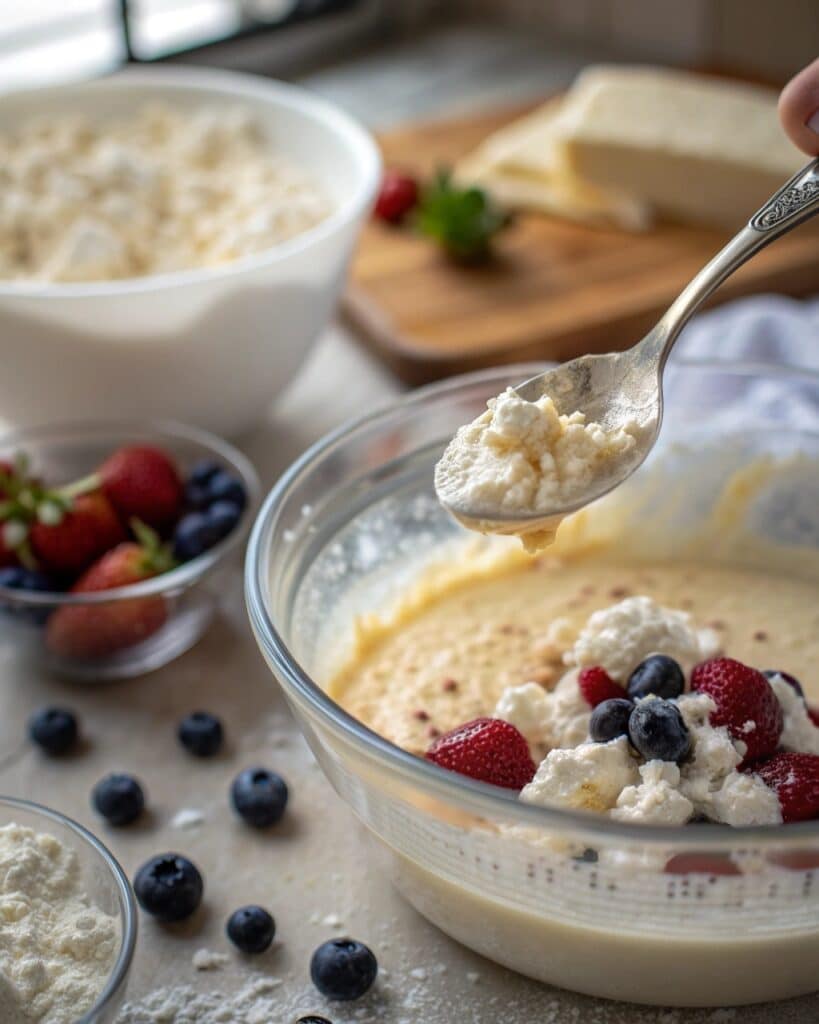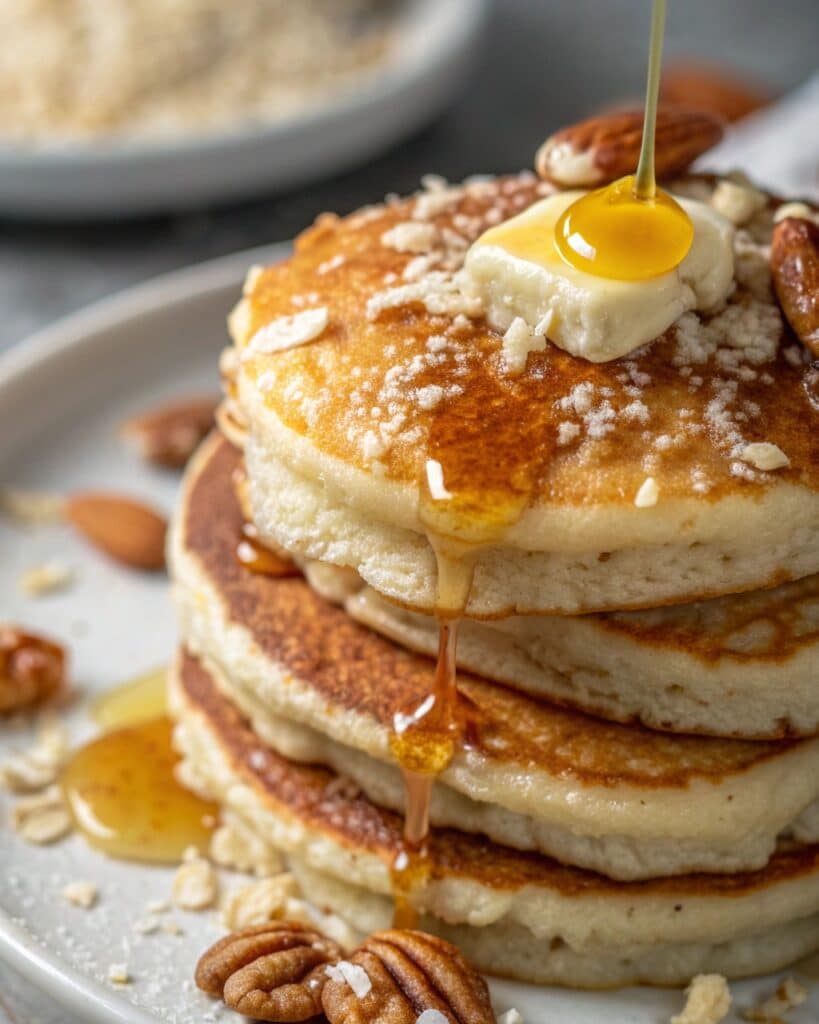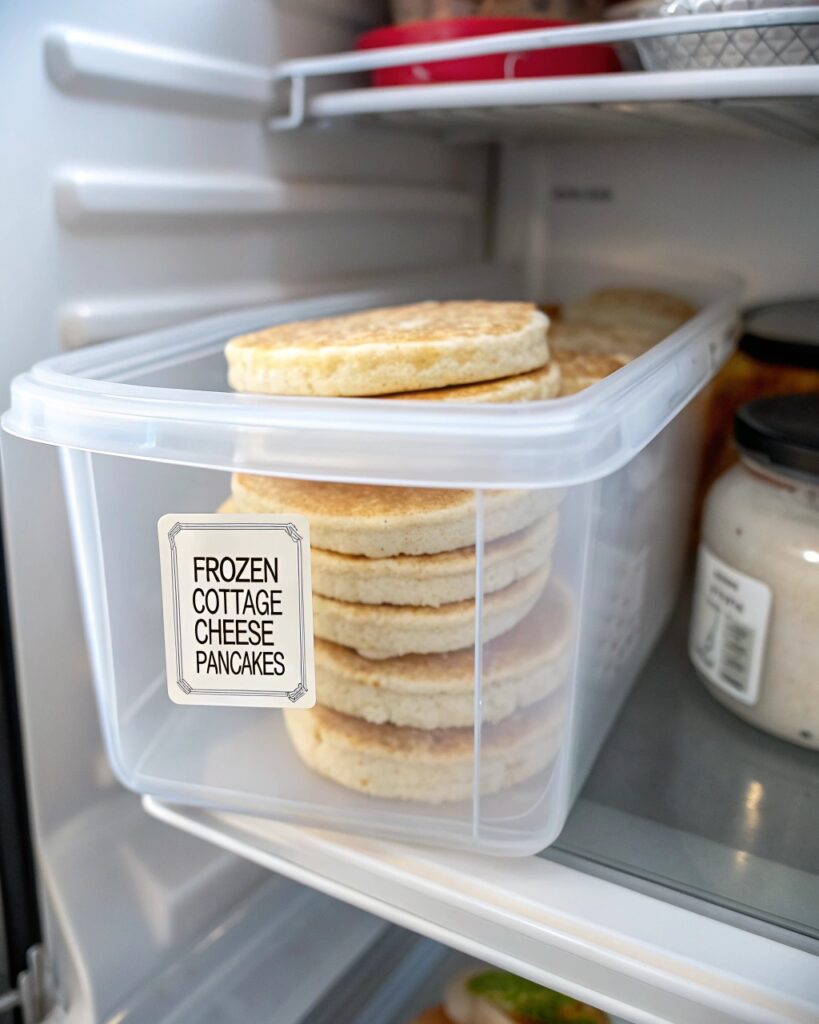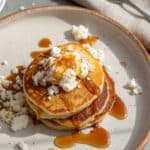Looking for a breakfast that checks all the boxes—gluten free, high in protein, and undeniably delicious? Cottage cheese gluten free pancakes might be your new go-to. These pancakes are not just fluffy and satisfying; they also pack a protein punch thanks to cottage cheese, while staying safe for gluten-sensitive or celiac individuals. Whether you’re trying to eat healthier, cut carbs, or just spice up your morning routine, this recipe hits the sweet spot.
In this article, we’ll break down why cottage cheese gluten free pancakes are trending, the best ingredients to use, which brands are gluten free, and how to make these pancakes fluffy and flavorful. Plus, we’ll answer your most asked questions, from freezing tips to how to mix cottage cheese into store-bought mixes.
Don’t miss our complete guide to gluten free breakfasts for more healthy inspiration.
Why Cottage Cheese Gluten Free Pancakes Are Trending
What Makes Cottage Cheese Pancakes Gluten Free?
Gluten free pancakes are made without wheat flour or any gluten-containing grains. By swapping traditional flour for gluten free alternatives—like almond, coconut, or oat flour—you can enjoy a stack without the stomach trouble. Cottage cheese itself is naturally gluten free (when no additives or stabilizers are included), making it a great high-protein base ingredient.
Gluten free pancake recipes have exploded in popularity as more people adopt gluten-conscious or celiac-friendly diets. Cottage cheese is the unsung hero here—it creates moist, protein-rich pancakes that taste indulgent without being unhealthy.
The Rise of High-Protein, Low-Carb Breakfast Trends
The demand for low-carb, high-protein meals has led to the reinvention of traditional breakfast staples. Cottage cheese gluten free pancakes fit perfectly into this health-forward trend. They’re favored by fitness enthusiasts, busy moms, and anyone trying to maintain energy levels throughout the morning without a blood sugar crash.
These pancakes cater to multiple diets at once—gluten free, low sugar, high protein, and even low fat depending on your choice of cheese. That versatility has made them a trending recipe across food blogs and health communities alike.
Benefits of Using Cottage Cheese in Pancakes

Nutritional Value of Cottage Cheese in Gluten Free Diets
Cottage cheese is one of the most nutrient-dense ingredients you can fold into a gluten free breakfast. It’s low in carbs, high in protein, and packed with essential nutrients like calcium, B vitamins, and selenium. For those who avoid gluten but still want a satisfying meal, adding cottage cheese to pancakes offers the perfect balance of flavor and nutrition.
Here’s a quick nutritional profile per ½ cup of low-fat cottage cheese:
| Nutrient | Amount |
|---|---|
| Protein | 14g |
| Carbs | 3-4g |
| Fat | 2g |
| Calcium | 10% DV |
| Sodium | 400mg |
In gluten free diets, where processed carb substitutes are often high in sugar or low in nutrients, cottage cheese acts as a whole food solution. It supports muscle repair, balances blood sugar, and keeps you full longer—essential for starting your day right.
Protein Content and Its Health Benefits
Protein plays a vital role in muscle building, metabolism, and even weight management. Traditional pancakes made with wheat flour are typically high in carbs and low in protein, which can lead to blood sugar crashes. In contrast, cottage cheese gluten free pancakes can offer up to 15–20g of protein per serving, depending on the recipe.
This is especially helpful for:
- Athletes needing post-workout fuel
- Diabetics aiming to control insulin spikes
- Busy professionals who need long-lasting energy
Additionally, using gluten free flours like almond or oat flour alongside cottage cheese helps amplify the protein-to-carb ratio.
Choosing the Right Cottage Cheese Brand
Is Daisy Cottage Cheese Gluten Free?
Yes, Daisy cottage cheese is gluten free. According to the brand’s official labeling and statements, Daisy ensures that its classic and low-fat cottage cheese varieties are made without gluten-containing ingredients and are manufactured in facilities that avoid cross-contamination. This is a safe choice for those with gluten sensitivity or celiac disease.
What’s more, Daisy is known for its clean-label approach—no additives, stabilizers, or artificial ingredients. For anyone making cottage cheese gluten free pancakes, this brand is a reliable and accessible option available in most U.S. grocery stores.
Comparing Breakstone, Good Culture, and Other Brands
When choosing a cottage cheese for your pancakes, it’s important to read labels carefully. Some brands use stabilizers or flavorings that may introduce gluten. Here’s a quick comparison of popular brands:
| Brand | Gluten Free | Texture | Best For |
|---|---|---|---|
| Daisy | Yes | Creamy | Classic pancakes |
| Breakstone | Yes (verify per batch) | Slightly thick | Blended recipes |
| Good Culture | Yes | Tangy & thick | High-protein recipes |
| Knudsen | Check label | Curdy | Savory pancakes |
| Lucerne | Yes | Creamy | Quick mixes |
- Breakstone Cottage Cheese is typically gluten free, but it’s recommended to check packaging, especially for flavored varieties. They may use additives that aren’t celiac-safe.
- Good Culture Cottage Cheese is also gluten free and organic. It’s packed with probiotics, making it a great gut-healthy addition to your breakfast stack.
Always look for certifications and allergen statements on packaging. If in doubt, choose plain, full-fat varieties with minimal ingredients.
Check out our list of gluten free cheese brands to make safer kitchen choices.
How to Make Cottage Cheese Gluten Free Pancakes

Basic Recipe Using Almond Flour or Oat Flour
Making cottage cheese gluten free pancakes from scratch is easier than you might think. With just a few simple, naturally gluten free ingredients, you can whip up a fluffy, protein-packed breakfast in under 15 minutes.
Here’s a classic recipe using almond flour (you can substitute with oat flour for a softer texture):
Ingredients:
- ½ cup full-fat cottage cheese (Daisy or Good Culture recommended)
- 2 large eggs
- ¼ cup almond flour
- 1 tbsp gluten free rolled oats (optional for texture)
- ½ tsp baking powder (ensure gluten free)
- ½ tsp vanilla extract
- Pinch of salt
- Butter or coconut oil for cooking
Instructions:
- In a bowl, whisk eggs until fluffy.
- Add cottage cheese and vanilla; stir to combine.
- Fold in almond flour, baking powder, oats, and salt.
- Heat a non-stick pan over medium heat; add butter or oil.
- Pour batter into small pancake rounds (2-3 inches wide).
- Cook 2–3 minutes per side until golden and cooked through.
These pancakes are thick, moist, and lightly sweet on their own—but they’re also the perfect canvas for toppings.
Don’t miss our easy pancake topping guide for flavor-packed ideas.
Vegan, Low-Carb, and High-Protein Variations
To adapt for dietary needs:
- Vegan version: Replace eggs with flax eggs (1 tbsp flaxseed + 2.5 tbsp water per egg), and use a plant-based cottage cheese alternative.
- Lower carb: Skip the oats and use coconut flour in small amounts (start with 1 tbsp—it absorbs a lot of moisture).
- Higher protein: Add 1 scoop of unflavored or vanilla protein powder and a bit more almond milk to adjust consistency.
With endless variations, you can customize your cottage cheese gluten free pancakes for fitness goals, dietary needs, or just your taste preferences.
Looking for inspiration? Try our keto cottage cheese pancake twist for even fewer carbs and more protein.
Enhancing Your Pancake Batter with Cottage Cheese
How to Add Cottage Cheese to Pancake Mix
If you’re short on time but still want the benefits of cottage cheese in your breakfast, good news: you can absolutely add it to your favorite gluten free pancake mix. The trick is balancing moisture and texture so the batter doesn’t become too wet or lumpy.
Here’s how to do it:
- Use full-fat or low-fat plain cottage cheese (not whipped or flavored).
- For every 1 cup of dry pancake mix, add ¼ to ½ cup of cottage cheese.
- Whisk the cottage cheese with the wet ingredients first to break it up.
- Add wet to dry and stir gently—don’t overmix.
- Let the batter sit for 5–10 minutes to thicken before cooking.
Adding cottage cheese this way boosts the protein content and flavor, giving a creamy texture inside the pancake without overwhelming the mix.
Check out our favorite gluten free pancake mix hacks to upgrade your boxed batter game.
Can You Mix Cottage Cheese into Kodiak Cakes?
Yes, and it’s a great idea! Kodiak Cakes are a high-protein pancake mix brand, and several of their varieties are labeled gluten free (always check the box). Adding cottage cheese to Kodiak mix creates an ultra-filling, protein-rich breakfast that doesn’t taste like a “health food.”
Tips for best results:
- Use ⅓ cup cottage cheese per ½ cup dry mix
- Add a splash of milk to adjust consistency
- Blend for a smooth texture, or fold gently for a rustic, chunky feel
- Top with berries or nut butter to balance flavor
This combo is popular among fitness enthusiasts and families alike because it satisfies hunger for hours while staying gluten free and protein-packed.
Discover great ideas like our Kodiak mix cottage cheese breakfast muffins for meal-prep-friendly options.
Storage and Meal Prep Tips

Can You Freeze Cottage Cheese Pancakes?
Absolutely. Cottage cheese gluten free pancakes freeze surprisingly well, making them perfect for meal prep or batch breakfasts. Because they’re thicker and moister than traditional pancakes, they hold their texture during freezing and reheating.
To freeze:
- Let pancakes cool completely on a wire rack (prevents sogginess).
- Layer them between parchment paper.
- Store freezer-safe bag for up to 2 months.
- Label with date and flavor variations if applicable.
Reheating tips:
- Use a toaster or skillet for best texture
- Microwave for convenience, but expect softer results
- Air fry for a crisp edge in under 3 minutes
This method keeps your high-protein, gluten free breakfast ready in minutes—even on hectic mornings.
Don’t miss our freezer-friendly pancake meal prep guide for bulk cooking tips and storage safety.
Best Practices for Storing Leftovers
If you’re storing pancakes in the fridge for short-term use (up to 4 days):
- Place in an airtight container
- Keep layers separated by parchment or wax paper
- Reheat in a pan with a splash of water and cover to steam and soften
Important: Because these pancakes contain dairy (cottage cheese), they’re more sensitive to spoilage than dry or boxed pancake recipes. Always smell and check texture before reheating.
For meal prepping, you can even prepare the batter a day in advance. Just give it a quick stir before cooking, as the flour may settle or thicken slightly overnight.
Looking for inspiration? Try our weekly gluten free breakfast planner to make the most of your batch cooking.
Common Mistakes and How to Avoid Them
Overmixing Cottage Cheese into Batter
One of the most common pitfalls when making cottage cheese gluten free pancakes is overmixing the batter. Unlike traditional pancakes, where a bit of gluten can help with structure, gluten free pancakes rely more on gentle mixing to maintain fluffiness and prevent a rubbery texture.
What happens when you overmix?
- Cottage cheese may break down too much and lose its creamy texture
- Air gets knocked out of the batter, leading to flat, dense pancakes
- The pancakes can turn gummy if gluten free flours like oat or almond are overstirred
How to avoid it:
- Mix wet ingredients separately, then gently fold into dry ingredients
- Stop as soon as ingredients are combined—lumps are okay
- Let the batter rest for 5–10 minutes to help the flours hydrate naturally
Learn more about techniques for light and fluffy gluten free pancakes.
Gluten Cross-Contamination Risks in Cooking
Even if your ingredients are certified gluten free, your cooking process might not be. Cross-contamination is a real concern for people with celiac disease or severe gluten sensitivity. Just a small trace of gluten from utensils, pans, or surfaces can cause digestive issues.
Avoid these mistakes:
- Using a shared spatula or griddle that’s been in contact with wheat-based products
- Reusing oil or butter from previous gluten-containing recipes
- Storing pancake mix next to regular flour (airborne particles matter!)
Best practices:
- Designate gluten free tools in your kitchen
- Clean griddles or pans thoroughly before each use
- Use sealed containers to store gluten free flours and ingredients
Check out our guide to creating a gluten free safe-zone in your kitchen for step-by-step organization tips.
FAQs About Cottage Cheese Gluten Free Pancakes
Is Daisy Cottage Cheese Gluten Free?
Yes, Daisy cottage cheese is naturally gluten free. It contains only a few simple ingredients and is made without stabilizers or additives that could introduce gluten. It’s a reliable choice for gluten sensitive and celiac individuals.
Is Breakstone Cottage Cheese Gluten Free?
Breakstone’s plain cottage cheese is considered gluten free, but it’s important to check the label. While the base ingredients typically don’t contain gluten, flavored or low-fat varieties may include thickeners or stabilizers that do.
Is Good Culture Cottage Cheese Gluten Free?
Yes, Good Culture’s cottage cheese is certified gluten free. It also contains live and active probiotics, making it a gut-friendly and nutritious option for those seeking both taste and health benefits in their pancakes.
Are Cottage Cheese Pancakes Healthy?
Cottage cheese pancakes are generally very healthy, especially when made gluten free. They’re rich in protein, low in sugar (depending on toppings), and contain fewer carbs than traditional pancakes. You can boost fiber and nutrient content by adding almond flour, chia seeds, or oats.
Can You Freeze Cottage Cheese Pancakes?
Yes, these pancakes freeze exceptionally well. Let them cool completely, separate with parchment, and freeze in an airtight container. Reheat using a toaster, skillet, or microwave for a fast and healthy breakfast anytime.
Can I mix Cottage Cheese to Kodiak Pancake ?
Yes. Kodiak Cakes mixes—especially the gluten free varieties—work great with cottage cheese. Just blend it into the wet ingredients to add extra protein and creaminess without affecting texture.
How to Add Cottage Cheese to Pancake Mix?
Whisk the cottage cheese with eggs and milk before adding to your dry mix. Use ¼ to ½ cup per 1 cup of pancake mix. Don’t overmix—leave it slightly lumpy for best results.
Conclusion: Why Cottage Cheese Gluten Free Pancakes Should Be Your Next Breakfast Stapl
If you’re looking for a gluten free breakfast that’s nutritious, delicious, and easy to prepare, cottage cheese gluten free pancakes are the answer. They’re loaded with protein, naturally low in carbs, and customizable for every diet—from keto to vegetarian.
Whether you’re starting from scratch or upgrading a store-bought mix, incorporating cottage cheese brings moisture, flavor, and real nutritional value to your plate. Plus, with the right brand and technique, you can avoid gluten, prep ahead, and enjoy your pancakes on the go or at the table with your favorite toppings.
Looking for inspiration? Try our ultimate list of healthy gluten free pancake recipes.
Don’t miss our banana oat pancake variation for a fruit-forward twist.
Check out our high-protein breakfast bowls to pair with your pancakes.
Discover great ideas like cottage cheese smoothie recipes for a balanced morning meal.

Cottage Cheese Gluten Free Pancakes – The Perfect Healthy Breakfast Option
- Total Time: 15 minutes
- Yield: 2 servings 1x
Description
These cottage cheese gluten free pancakes are fluffy, high-protein, and perfect for a healthy breakfast or meal prep. Naturally gluten free and easy to make with just a few ingredients.
Ingredients
- ½ cup full-fat cottage cheese
- 2 large eggs
- ¼ cup almond flour
- ½ tsp baking powder (gluten free)
- ½ tsp vanilla extract
- Pinch of salt
- Butter or coconut oil (for cooking)
Instructions
- In a medium bowl, whisk the eggs until frothy.
- Stir in cottage cheese and vanilla extract until well combined.
- Fold in almond flour, baking powder, and salt.
- Preheat a non-stick skillet over medium heat and lightly grease with butter or coconut oil.
- Scoop batter into the pan to form 3-inch pancakes.
- Cook for 2–3 minutes on each side, until golden brown and cooked through.
- Serve warm with your favorite toppings.
Notes
- Use oat flour instead of almond flour for a softer texture.
- Add cinnamon, chia seeds, or mashed banana for variety.
- These pancakes freeze well for up to 2 months.
- Let the batter sit for 5–10 minutes to thicken before cooking.
- Prep Time: 5 minutes
- Cook Time: 10 minutes
- Category: Breakfast
- Method: Skillet
- Cuisine: American
Nutrition
- Serving Size: 1 stack (½ recipe)
- Calories: 220
- Sugar: 1g
- Sodium: 430mg
- Fat: 10g
- Saturated Fat: 4g
- Unsaturated Fat: 5g
- Trans Fat: 0g
- Carbohydrates: 6g
- Fiber: 2g
- Protein: 14g
- Cholesterol: 190mg

